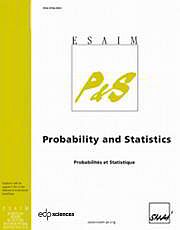Crossref Citations
This article has been cited by the following publications. This list is generated based on data provided by
Crossref.
del Barrio, Eustasio
2010.
Comments on: l 1-penalization for mixture regression models.
TEST,
Vol. 19,
Issue. 2,
p.
276.
Kruijer, Willem
Rousseau, Judith
and
van der Vaart, Aad
2010.
Adaptive Bayesian density estimation with location-scale mixtures.
Electronic Journal of Statistics,
Vol. 4,
Issue. none,
Bontemps, Dominique
and
Toussile, Wilson
2013.
Clustering and variable selection for categorical multivariate data.
Electronic Journal of Statistics,
Vol. 7,
Issue. none,
Maugis-Rabusseau, C.
and
Michel, B.
2013.
Adaptive density estimation for clustering with Gaussian mixtures.
ESAIM: Probability and Statistics,
Vol. 17,
Issue. ,
p.
698.
Cohen, S. X.
and
Le Pennec, E.
2013.
Partition-based conditional density estimation.
ESAIM: Probability and Statistics,
Vol. 17,
Issue. ,
p.
672.
Meynet, Caroline
2013.
Anℓ1-oracle inequality for the Lasso in finite mixture Gaussian regression models.
ESAIM: Probability and Statistics,
Vol. 17,
Issue. ,
p.
650.
Gassiat, Elisabeth
and
van Handel, Ramon
2013.
The local geometry of finite mixtures.
Transactions of the American Mathematical Society,
Vol. 366,
Issue. 2,
p.
1047.
Cohen, S.X.
and
Le Pennec, E.
2014.
Unsupervised Segmentation of Spectral Images with a Spatialized Gaussian Mixture Model and Model Selection.
Oil & Gas Science and Technology – Revue d’IFP Energies nouvelles,
Vol. 69,
Issue. 2,
p.
245.
Baraud, Yannick
and
Birgé, Lucien
2014.
Estimating composite functions by model selection.
Annales de l'Institut Henri Poincaré, Probabilités et Statistiques,
Vol. 50,
Issue. 1,
Bontemps, Dominique
and
Gadat, Sébastien
2014.
Bayesian methods for the Shape Invariant Model.
Electronic Journal of Statistics,
Vol. 8,
Issue. 1,
Montuelle, L.
and
Le Pennec, E.
2014.
Mixture of Gaussian regressions model with logistic weights, a penalized maximum likelihood approach.
Electronic Journal of Statistics,
Vol. 8,
Issue. 1,
Baudry, Jean-Patrick
2015.
Estimation and model selection for model-based clustering with the conditional classification likelihood.
Electronic Journal of Statistics,
Vol. 9,
Issue. 1,
Mehrjou, Arash
Hosseini, Reshad
and
Nadjar Araabi, Babak
2016.
Improved Bayesian information criterion for mixture model selection.
Pattern Recognition Letters,
Vol. 69,
Issue. ,
p.
22.
Gassiat, E.
Cleynen, A.
and
Robin, S.
2016.
Inference in finite state space non parametric Hidden Markov Models and applications.
Statistics and Computing,
Vol. 26,
Issue. 1-2,
p.
61.
Delattre, Maud
Genon-Catalot, Valentine
and
Samson, Adeline
2016.
Mixtures of stochastic differential equations with random effects: Application to data clustering.
Journal of Statistical Planning and Inference,
Vol. 173,
Issue. ,
p.
109.
Devijver, Emilie
2017.
Joint rank and variable selection for parsimonious estimation in a high-dimensional finite mixture regression model.
Journal of Multivariate Analysis,
Vol. 157,
Issue. ,
p.
1.
Verzelen, Nicolas
and
Arias-Castro, Ery
2017.
Detection and feature selection in sparse mixture models.
The Annals of Statistics,
Vol. 45,
Issue. 5,
Devijver, Emilie
and
Gallopin, Mélina
2018.
Block-Diagonal Covariance Selection for High-Dimensional Gaussian Graphical Models.
Journal of the American Statistical Association,
Vol. 113,
Issue. 521,
p.
306.
Aflakparast, Mehran
de Gunst, Mathisca C. M.
and
van Wieringen, Wessel N.
2018.
Reconstruction of molecular network evolution from cross‐sectional omics data.
Biometrical Journal,
Vol. 60,
Issue. 3,
p.
547.
Nguyen, Hien D.
and
McLachlan, Geoffrey J.
2018.
Some theoretical results regarding the polygonal distribution.
Communications in Statistics - Theory and Methods,
Vol. 47,
Issue. 20,
p.
5083.

